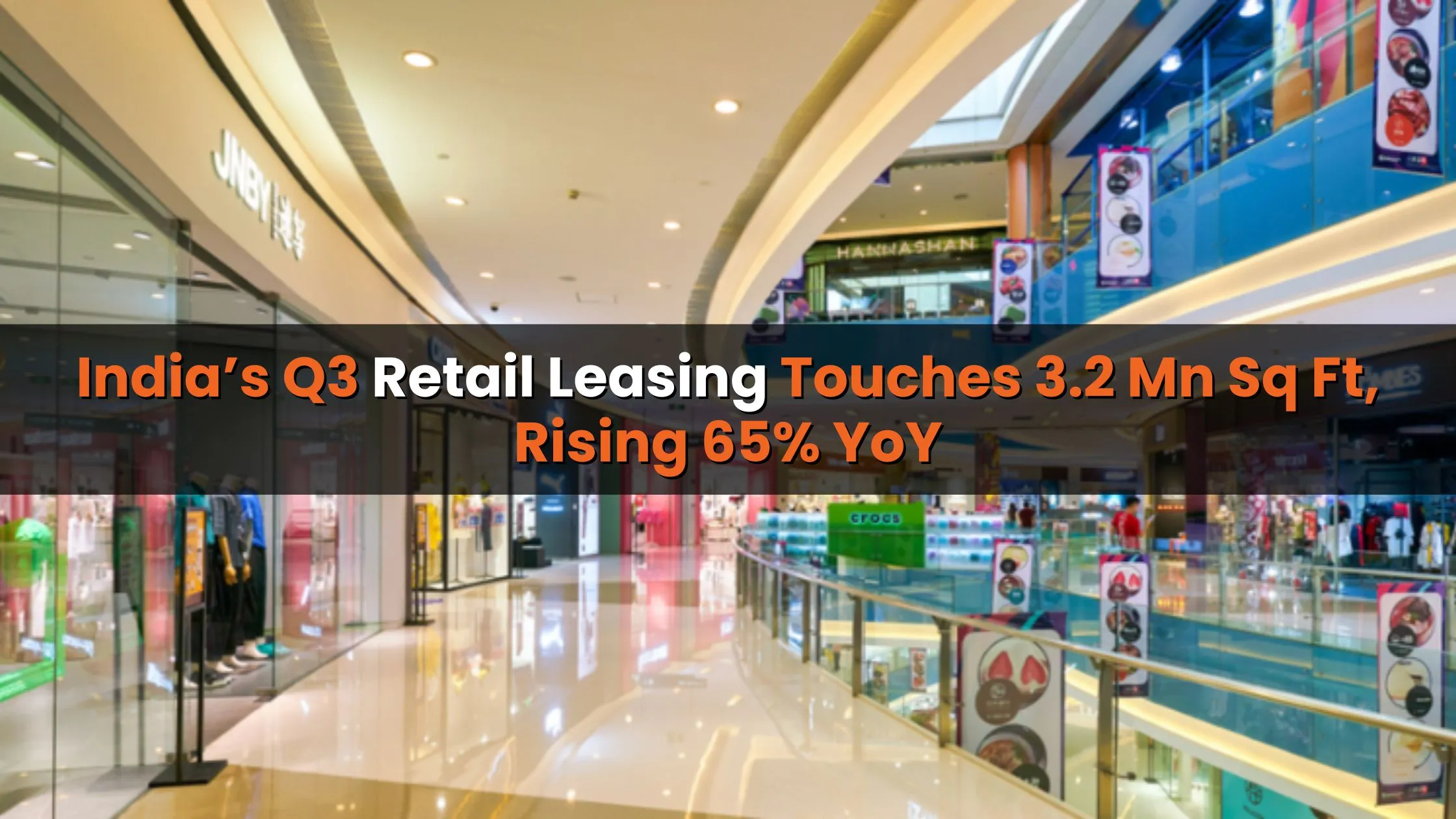Table of Content
- India’s Retail Leasing Surges 65% YoY in Q3 2025
- Supply Pipeline Indicates Stronger Activity Ahead
- Shopping Malls and High Streets Lead Demand
- Delhi-NCR and Hyderabad Dominate India Retail Leasing Momentum
- Sector-Wise Breakdown: Who Is Driving Retail Expansion?
- Domestic Retailers Lead, While Luxury Segment Gains Momentum
- Expert Insights
- Outlook
India’s retail sector continues to gather impressive momentum, reflecting a revival in consumer sentiment, strong brand expansion, and growing interest from both domestic and global players. The latest data shows that India's retail leasing surged sharply in Q3 2025, driven by new mall supply, robust high-street activity, and deepening investments by retailers across categories. With Delhi-NCR and Hyderabad contributing a combined 57% share of quarterly leasing, the country’s top metros are reinforcing their position as retail hotspots.
India’s Retail Leasing Surges 65% YoY in Q3 2025
The July–September quarter marked a significant acceleration for India's retail leasing, with total gross absorption reaching 3.2 million sq ft across the top seven cities. This represents a 65% year-on-year growth, underscoring the strong recovery of the retail ecosystem.
With this quarterly performance, leasing activity for the first nine months of 2025 has already touched 8.9 million sq ft, well ahead of the previous year’s pace. The JLL analysis covers major retail destinations, including Delhi-NCR, Hyderabad, Mumbai, Bengaluru, Chennai, Kolkata, and Pune, all of which recorded stable or rising activity as brands continued to add physical stores.
Also Read: India’s Data Centre Capacity Surpasses 1.5 GW, Mumbai Holds 53% Share
Supply Pipeline Indicates Stronger Activity Ahead
The momentum in India retail leasing is expected to strengthen further as the year progresses. Nearly 4.7 million sq ft of new mall supply is scheduled for completion in Q4 2025 alone, marking one of the strongest quarterly pipelines in recent years.
Given the robust demand environment, total leasing is now projected to exceed earlier estimates of 10 million sq ft for the full year. This confidence reflects a long-term shift in retailer strategy as brands prioritise flagship formats, larger footprints, and expansion into new micro-markets.
Shopping Malls and High Streets Lead Demand
Shopping malls and high streets together contributed the bulk of India's retail leasing in Q3 2025.
- Malls accounted for 53% of leasing, supported by strong demand for Grade A retail spaces.
- High streets contributed 41%, continuing their upward trajectory as retailers seek locations with strong visibility, footfall, and lower occupancy costs.
The balanced growth across both formats signals a diversified expansion strategy, with brands opting for premium malls in metros while leveraging high streets to reach dense residential catchments.
Delhi-NCR and Hyderabad Dominate India Retail Leasing Momentum
City-level data shows that Delhi-NCR and Hyderabad were the biggest contributors to India's retail leasing in Q3.
- Delhi-NCR led with a 35% share, fuelled by space take-up in two newly operational malls and continued interest from fashion and lifestyle brands.
- Hyderabad accounted for 12%, driven primarily by high-street expansions as retailers deepen their presence across fast-growing suburban clusters.
Other major markets also recorded healthy activity:
- Mumbai absorbed 0.6 million sq ft, led by brands targeting prime mall locations.
- Bengaluru saw 0.4 million sq ft of leasing as its tech-driven consumer base remained attractive to retailers.
- Chennai and Kolkata maintained steady leasing levels.
- Pune witnessed a marginal dip compared to Q2, though demand remained stable across neighbourhood high streets.
Sector-Wise Breakdown: Who Is Driving Retail Expansion?
The growth in India's retail leasing was broad-based, but a few categories stood out:
- Fashion & apparel: 35% share
- Food & beverage: 16%
- Daily needs & grocery: 11%
These categories continued to anchor mall performance, especially as daily needs and grocery retailers expanded aggressively into large-format stores. This quarter also saw stronger interest from F&B operators, driven by experiential dining trends in urban markets.
Direct-to-consumer (D2C) brands are playing a growing role in the offline retail space, particularly in apparel, beauty, wellness, and jewellery. Their click-and-mortar strategy is helping them capture a wider consumer base across top metros.
Domestic Retailers Lead, While Luxury Segment Gains Momentum
Domestic retail brands led leasing activity in Q3 2025, absorbing 2.6 million sq ft, marking a 76% YoY growth. International brands accounted for 19% of leasing, maintaining their steady presence in India’s growing consumer market.
The luxury segment has also seen an upturn. From January to September 2025, luxury retailers leased 0.2 million sq ft, a 19% YoY increase. The rise in luxury leasing highlights the availability of investment-grade retail infrastructure, premium malls, curated high street belts, and flagship-ready spaces suitable for top-tier global brands.
Also Read: Pune Real Estate Reports 39% Decline in Sales, ₹527 Crore Stamp Duty in Oct 2025
Expert Insights
Industry experts highlight several key trends driving India retail leasing this year:
- Strong demand from fashion, grocery, and F&B players
- Faster adoption of physical stores by digital-first brands
- Increasing availability of high-quality mall supply
- Expanding appetite for large-format stores in urban areas
Analysts also predict that retailers will continue prioritising catchments offering robust footfall, favourable demographics, and high spending potential.
Outlook
The outlook for India's retail leasing remains strongly positive for the remainder of 2025. With a healthy supply pipeline, strong brand expansion plans, and resilient consumer demand, total leasing activity is expected to comfortably surpass annual forecasts.
New mall launches, growing D2C investments, and continued luxury retail expansion will play a key role in driving momentum. Major metros such as Delhi-NCR, Mumbai, Hyderabad, and Bengaluru will remain the primary engines of growth, supported by increasing activity in Tier 1 suburban corridors.



_1765444636.webp)
_1765438259.webp)


Ans 1. India’s retail sector leased 3.2 million sq ft of space in Q3 2025, marking a 65% year-on-year growth compared to the same quarter last year.
Ans 2. Delhi-NCR and Hyderabad led the momentum, accounting for a combined 57% of total quarterly leasing, followed by Mumbai, Bengaluru, Chennai, Kolkata, and Pune.
Ans 3. Retail leasing growth was primarily driven by shopping malls (53%) and high streets (41%), reflecting a balanced expansion strategy between premium mall locations and high-footfall neighbourhood areas.
Ans 4. Key sectors included: Fashion & apparel – 35% share, Food & beverage (F&B) – 16%, Daily needs & grocery – 11%, Other segments like beauty, wellness, and jewellery (D2C brands) also showed rising interest in physical store expansion.
Ans 5. Domestic retailers led leasing, absorbing 2.6 million sq ft, a 76% YoY increase, while international brands accounted for 19% of total leasing.
Ans 6. The luxury retail segment showed positive growth, with 0.2 million sq ft leased between January and September 2025, reflecting a 19% YoY increase. Premium malls and curated high street belts are key drivers of this segment.
Ans 7. Nearly 4.7 million sq ft of new mall space is expected to be completed in Q4 2025, indicating a strong pipeline for continued leasing activity.
Ans 8. While Delhi-NCR, Mumbai, Hyderabad, and Bengaluru lead, Tier 1 suburban corridors and growth areas in cities like Pune and Chennai are witnessing rising leasing activity.